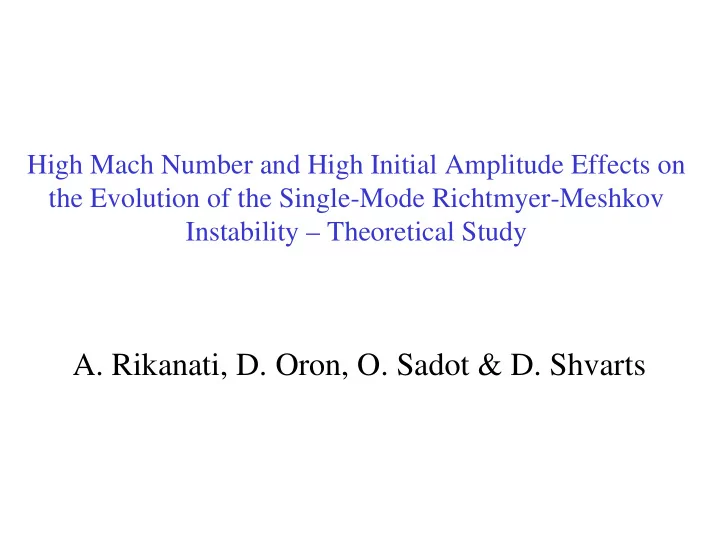

High Mach Number and High Initial Amplitude Effects on the Evolution of the Single-Mode Richtmyer-Meshkov Instability – Theoretical Study A. Rikanati, D. Oron, O. Sadot & D. Shvarts
Impulsive Models for the Small Amplitude Single-Mode RM Instability Assuming low mach (SW effects as a - delta function acceleration) and small amplitudes (ak<<1): S.W. − ρ ρ 1 2 u u k a = ∆ ⋅ ⋅ bubble 1 d 0 + ρ ρ 1 2 k – wavelength ∆ u 1d -velocity of unperturbed contact surface induced by shock wave ρ 1 , ρ 2 - shocked densities before and after contact surface Slow - Fast interaction Fast - Slow interaction (phase inversion) Richtmyer Formula : Meyer-Blewett correction : a + + a − a a + 0 0 = a 0 0 = 0 2 a + - post shock amplitude a + - post shock amplitude 0 0 a − - pre shock amplitude 0
Results from New Shock Tube Experimental by Sadot et. al. M=1.2 (E36) λ =40mm λ =80mm λ =26mm a - =12mm a - =20mm a - =10mm
Experimental Velocity Reduction Class A Experiments: Similar reduction at a range of Mach numbers (1.2-15.3) Apparent High Amplitude Effect Class B Experiments: Dimonte Be → Foam (M=15.3) Can be High Mach Effect Aleshin Ar → Xe (M=2.5) Sadot Air → SF 6 (M=1.2) Aleshin He → Xe (M=2.5)
Vorticity Deposition Model y α x Initial Interface Incident Shock-Wave • Local vorticity deposition per unit length * : ( , , , , ) ds Γ M sin( α) ds Γ = γ γ ρ ρ 0 1 2 1 2 • Bubble tip velocity: u ( z ) i v ( z ) 2 ( z ) cot(( z z ' ) / d ) dz ' − ⋅ = Γ − ⋅ ∫ π π interface z x i y = + ⋅ * R. Samtaney and N. J. Zabusky, Phys. Fluids A 5 , 1285 (1993)
Model Velocity Reduction Compared with class ‘A’ Experiments and Simulations New shock Tube Experiments Experiments by Dimonte and Aleshin In class ‘A’ experiments the velocity reduction is mainly attributed to high amplitudes effects.
Compressibility dominated regimes Compressibility effects are expected to dominate the flow when the shock wave is in proximity with the interface. f c = 1 contour lines Shock front Bubble λ Bubble d u f bouble Proximity criterion: = c u u shock 1 d − Conjecture: f c characterizes the flow at moderate Mach numbers
“Wall” model for moderate Mach RM instability • Shock wave is treated as a rigid straight wall moving in the 1d shock velocity. Bubbles Shock front • Secondary high pressure points are not considered. • Model reduction depends only on f c. Assumed Shock • Model is solved by using previous models * while inhibiting the shock as a moving boundary condition. * Potential model for A close to 1 and Vortex model for A close to 0.
Example of results from the Wall model •As the shock velocity increases ( f c decreases) the velocity profile is closer Richtmyer to the incompressible Velocity case. Reduced Velocity •The reduction factor is calculated by: Reduced Velocity Richtmyer Velocity
Comparison with Aleshin He → Xe experiments Rictmyer Veloctiy Classical Model Wall Model Sim./Exp. Reverberation arrivel time ⇒ By Introducing f c to the potential model, good agreement is achieved with experiments.
Class B Reduction Factor - Theory Vs. Experiments Model Exp. In class ‘B’ experiments the velocity reduction is mainly attributed to high Mach effects.
Late Nonlinear Stages of the Flow - Numerical Simulations at f c =0.05 and ak =0.175 - 1.75. Normelized Velocity Normelized Velocity Multiplied by Time ak= 0.175 ak= 0.436 ak= 0.872 ak= 1.75 ⇒ Normalizing the late stages of the flow by the initial velocity from the High Amplitudes Model, deduces high amplitudes effects. Hence the classic behavior is regained.
Late Nonlinear Stages of the Flow - Numerical Simulations for f c =0.05 - 0.625 and ak =0.43. Normelized Velocity f c =0.05 0.11 0.22 0.45 0.63 Reverberation time ⇒ At High values of f c new phenomena arises due to secondary high pressure points, drastically affecting the flow.
Summary • Effects of high initial amplitudes and Mach numbers were quantified for the early linear stages of the flow. • Classes ‘A’ and ‘B’ of experiments were recognized, distinguishing between the two effects. • For the late nonlinear stages of the flow: • No true effects were found for high initial amplitudes. • New dominant effects were found for high Mach numbers.
Recommend
More recommend